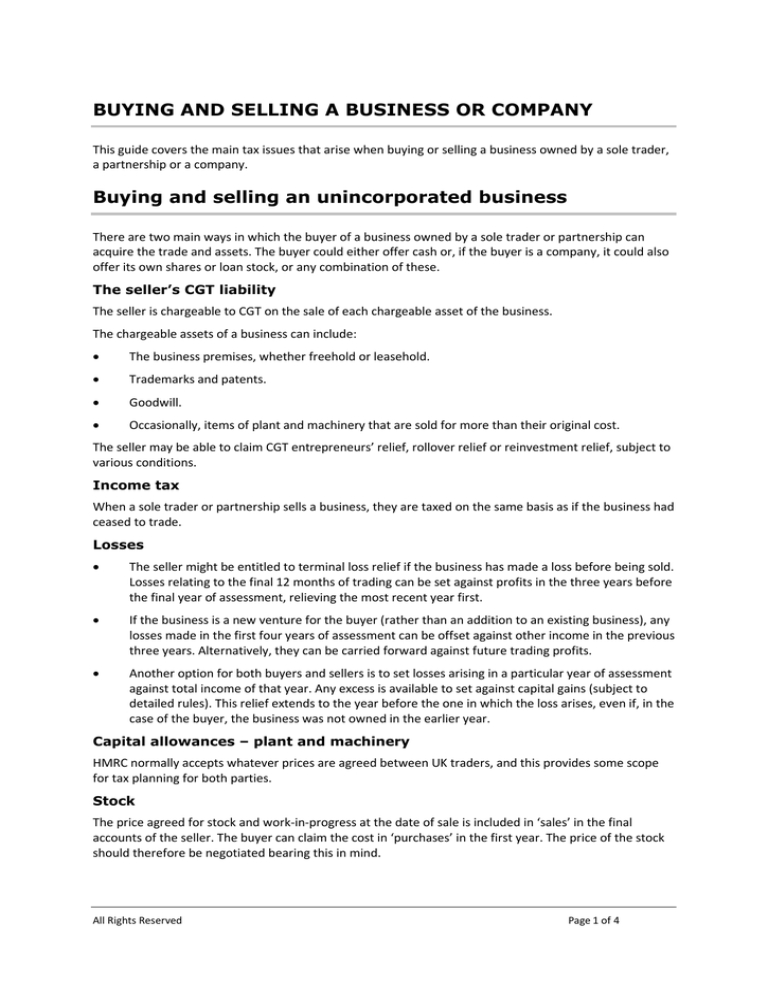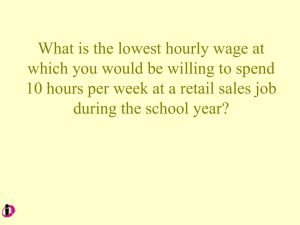
BUYING AND SELLING A BUSINESS OR COMPANY
This guide covers the main tax issues that arise when buying or selling a business owned by a sole trader,
a partnership or a company.
Buying and selling an unincorporated business
There are two main ways in which the buyer of a business owned by a sole trader or partnership can
acquire the trade and assets. The buyer could either offer cash or, if the buyer is a company, it could also
offer its own shares or loan stock, or any combination of these.
The seller’s CGT liability
The seller is chargeable to CGT on the sale of each chargeable asset of the business.
The chargeable assets of a business can include:
The business premises, whether freehold or leasehold.
Trademarks and patents.
Goodwill.
Occasionally, items of plant and machinery that are sold for more than their original cost.
The seller may be able to claim CGT entrepreneurs’ relief, rollover relief or reinvestment relief, subject to
various conditions.
Income tax
When a sole trader or partnership sells a business, they are taxed on the same basis as if the business had
ceased to trade.
Losses
The seller might be entitled to terminal loss relief if the business has made a loss before being sold.
Losses relating to the final 12 months of trading can be set against profits in the three years before
the final year of assessment, relieving the most recent year first.
If the business is a new venture for the buyer (rather than an addition to an existing business), any
losses made in the first four years of assessment can be offset against other income in the previous
three years. Alternatively, they can be carried forward against future trading profits.
Another option for both buyers and sellers is to set losses arising in a particular year of assessment
against total income of that year. Any excess is available to set against capital gains (subject to
detailed rules). This relief extends to the year before the one in which the loss arises, even if, in the
case of the buyer, the business was not owned in the earlier year.
Capital allowances – plant and machinery
HMRC normally accepts whatever prices are agreed between UK traders, and this provides some scope
for tax planning for both parties.
Stock
The price agreed for stock and work-in-progress at the date of sale is included in ‘sales’ in the final
accounts of the seller. The buyer can claim the cost in ‘purchases’ in the first year. The price of the stock
should therefore be negotiated bearing this in mind.
All Rights Reserved
Page 1 of 4
Stamp duty land tax and stamp duty
Transfer of property is liable to stamp duty land tax (SDLT) normally on the consideration paid. Stamp
duty is charged at 0.5% on the transfer of shares and marketable securities. The duty is payable by the
buyer.
Value added tax
Value added tax (VAT) is normally payable on taxable supplies made by a VAT-registered business, and
this includes the transfer of most assets on the sale of the business. Assets such as cash, debtors and
investments are not normally liable to VAT.
No VAT is payable on the sale of a going concern. This is a sale where the assets transferred are
used by the buyer in the same kind of business as that carried on by the seller.
Although it is possible to transfer the VAT registration from seller to buyer if the buyer is not yet
registered, the buyer should normally refuse. The transfer passes all the VAT liabilities of the seller
to the buyer. It is better for the buyer to register separately.
Sale of a business for shares
A company buying a business owned by a sole trader or partnership has the option of offering shares for
the business as well as or instead of cash. There are two main ways in which shares can be offered:
Route A – the purchasing company may offer shares in exchange for the business.
Route B – the purchasing company may offer shares in exchange for shares in a company owning
the underlying business. Under this route, there are two steps:
Step 1, the seller (sole trader or partnership) incorporates a company (Newco) and transfers
the business and assets into it.
Step 2, the seller exchanges the shares in Newco for shares in the acquiring company.
With both routes A and B, the seller has effectively disposed of the business assets in exchange for
shares. CGT can therefore arise on the chargeable assets in the same way as if they had been sold for
cash.
Under route A, the seller’s gains are taxable, based on the market value of those assets that are within
the scope of CGT, are taxable, and the buyer’s company has acquired the assets at their market value.
The seller can claim entrepreneurs’ relief subject to the usual conditions.
If route B is used, the seller can defer any gains by using two tax reliefs, subject to various conditions:
For step 1, ‘incorporation’ relief rolls over the gains into the shares in Newco.
Step 2 is a ‘share-for-share exchange’, in which the gains on Newco shares are rolled over into the
base cost of the shares in the purchasing company.
This double rollover ensures that capital gains on the disposal of the business are deferred until
the disposal of the shares in the purchasing company.
However, the deferral is at the expense of any entrepreneurs’ relief on the deferred gain, as the
purchasing company would not normally qualify as the seller’s personal company under the
entrepreneurs’ relief rules.
Loan stock
The purchasing company might offer to pay some or all of the purchase price by way of a loan or loan
stock, as an alternative to offering cash or shares. This saves the buyer having to find the cash
immediately. The buyer would agree to repay the loan at a specified future date or dates, and the loan is
likely to carry interest.
All Rights Reserved
Page 2 of 4
The tax is payable at the normal due date relating to the date of sale, even though the loan might not be
repaid for some time. If the loan is never fully repaid, a claim can be made to reduce the tax liability to
take account of the amount lost.
Buying and selling an incorporated business
There are three main ways to buy a business owned by a company. The buyer can:
Buy the company’s business and its assets; see ‘Sale of the business’ below.
Buy the shares in the company for cash, see ‘Sale of the company’ below.
If the buyer is a company, buy the shares in exchange for an issue of its own shares or loan stock.
Sale of the business from the company
The buyer can buy the business from the company. The company is then the seller.
The seller company is chargeable to tax on capital gains on the sale of each chargeable asset of the
business.
If the gains made by the company are distributed to the shareholders, the shareholders will usually
be liable to further tax.
The considerations with regard to capital allowances, stock, SDLT and VAT are essentially the same
when buying the assets of an incorporated business from a company.
A company with only one business to sell should continue operating right up to the sale date, particularly
if recent results are poor. When all trading activity stops in a company, it causes an accounting period to
end for tax purposes. The sale of the business would then take place in the next accounting period, and
there would be no trading losses in that period to offset the capital gain on the sale.
Sale of the company that owns the business
A buyer might buy the shares in the company that owns the business, instead of buying the underlying
business itself. The seller will often prefer to sell the shares rather than the assets. This avoids a double
tax charge on the sale of assets by the company followed by the extraction of the proceeds from the
company.
Capital gains The seller’s capital gain arises on the sale of the shares. In practice, there might be several
shareholders, who must calculate their own gain or loss under the usual rules. There is no rollover relief
on the sale of shares, but reinvestment relief under the EIS or SEIS might be available to individual
shareholders. Entrepreneurs’ relief may be available on a sale of shares in a trading company.
Corporation tax A company will normally still be carrying on the same business after a sale of its shares,
and so its tax position will generally not change. However, trading losses that arose before the date of
sale cannot normally be carried forward and relieved against profits after the sale if:
There is a major change in the nature or conduct of the trade within three years either side of the
sale date, and
The company’s trade is small or negligible at the date of sale.
VAT There is no transfer of the business for VAT because the business remains in the company. Unless
the company is part of a group VAT registration, the registration number is retained and any VAT
liabilities and potential penalties for making late returns in the past become the responsibility of the new
owners.
Other considerations
Sellers will often prefer to sell the company rather than its business and assets, unless they want to keep
some of the assets, such as a property, but for the buyer the issues are more complex.
All Rights Reserved
Page 3 of 4
Selling the business leaves the seller with the responsibility for the company’s liabilities and the
problem of extracting the company profits with the consequent tax costs.
For buyers, buying the business of a company has the advantage that buyers know what they are
getting, because the assets of the business are detailed in the purchase agreement.
SDLT on a purchase of assets may be higher than stamp duty on a purchase of shares, because of
the higher rates of duty.
A person buying a company buys it with all its actual and potential liabilities. For this reason,
buyers of companies should obtain a wide range of warranties and indemnities from the seller.
Tax planning key points
Buying or selling a business is a key financial decision, and there are often many different routes.
The available choices usually mean that there is plenty of scope for both arranging a good
commercial deal and also mitigating the possible tax liabilities. But these transactions are fraught
with pitfalls, both commercial and tax-related, and specific professional advice is crucial.
The decision is often about whether it should be an asset (business) or an entity (share)
transaction. Asset transactions require much less in the way of due diligence but often bear a
larger direct cost (e.g. CGT, VAT or SDLT). Share transactions, however, often give rise to hidden
charges, e.g. clawbacks of reliefs on the change of ownership.
Special care should be taken over the tax consequences of earn-out deals, where deferred
consideration is payable dependent on the company’s future results. The complexities of such
sales are beyond the scope of this topic.
This guide is for general information only and is not intended to be advice to any speci
recommended to seek competent professional advice before taking or refraining from taking action on the
e guide represents our understanding of the law and HM
Revenue & Customs practice as at April 2014
All Rights Reserved
Page 4 of 4






